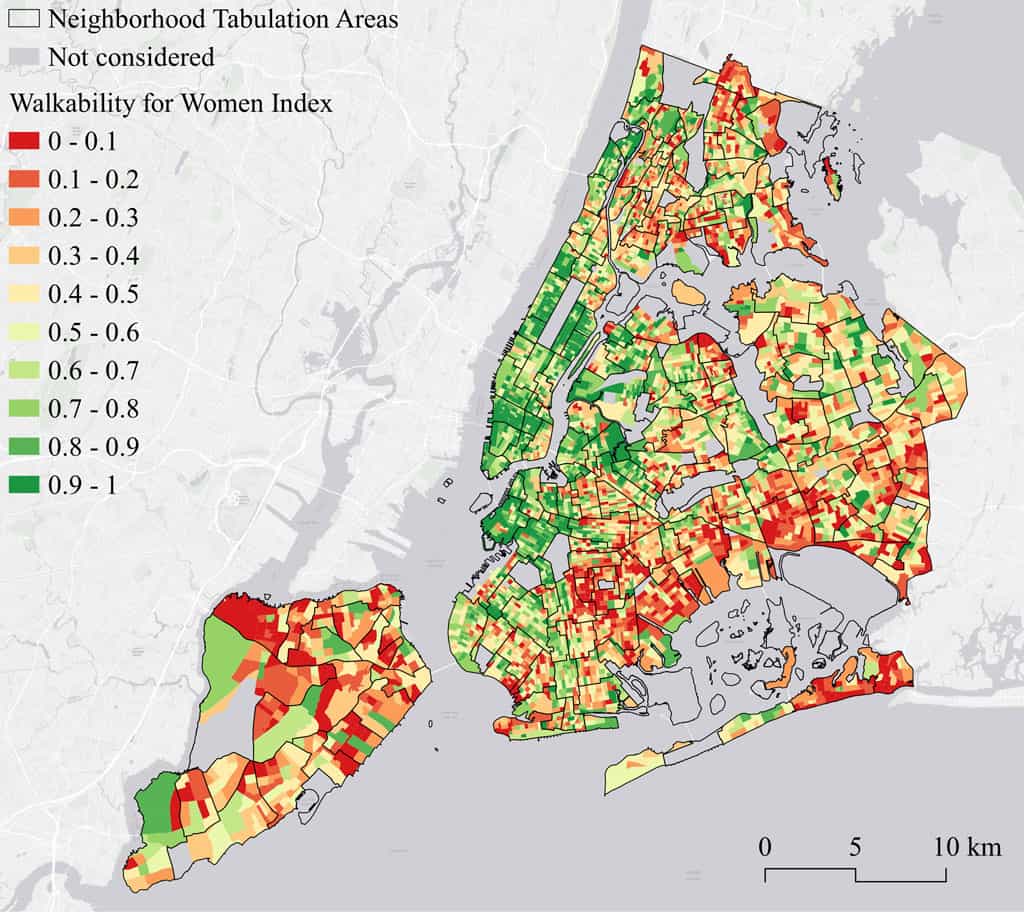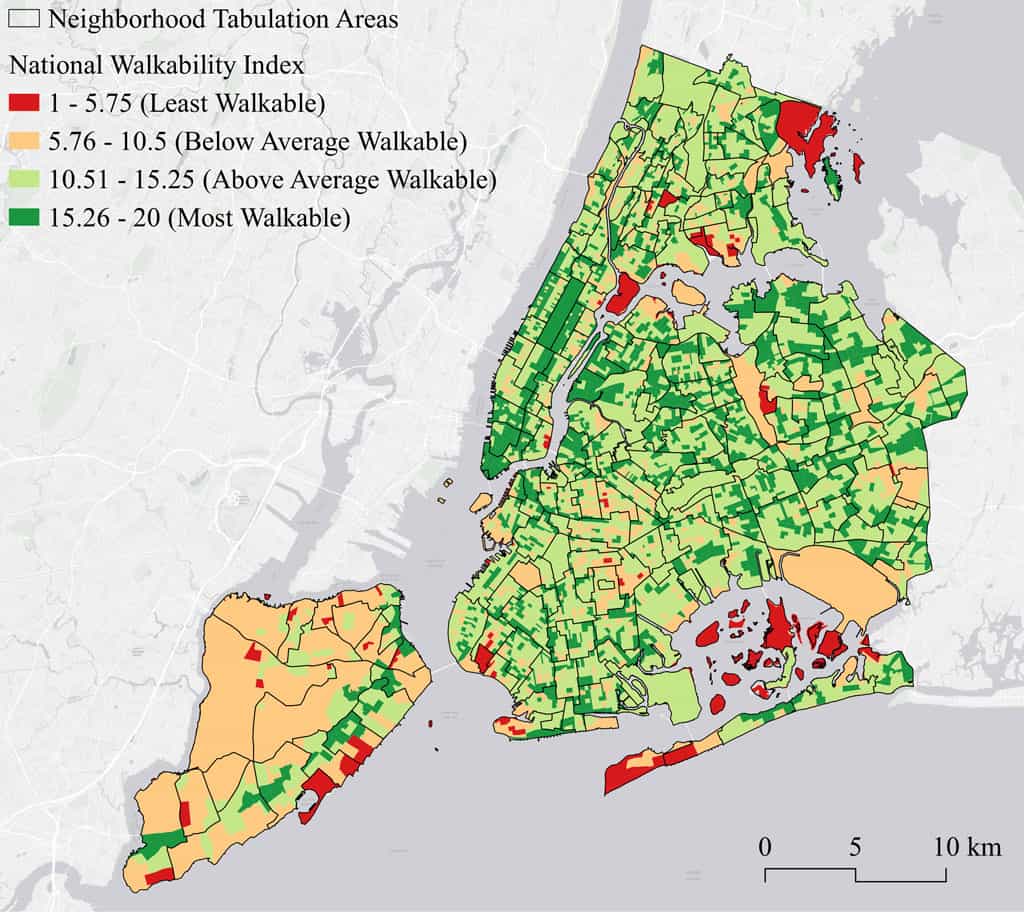Utilizing GIS and location-based open data, this study examined the level of walkability for women in New York City. As highlighted through a thematic literature review, women experience the city differently than men, since they are more concerned with security issues related to aggression and harassment, as a major inhibitor of mobility in public spaces especially at nighttime. The analysis focused on the level of usefulness, comfort, safety, security, and attractiveness of the city. The results of the proposed Walkability for Women Index (WWI) helped to identify and characterize a short list of suitable urban areas where to prioritize interventions. Moreover, the results of the proposed WWI have been compared to the National Walkability Index (NWI), in order to highlight the impact of individual characteristics of pedestrians on the perceived level of walkability.
User-centered approach for walkability assessment
Although traditional approaches related to walkability tend to focus on the spatial dimension (Wang and Yang, 2019), individual characteristics of city users have a significant impact on the perceived level of pedestrian friendliness of streets and public spaces (e.g., demographics and socioeconomics characteristics, travel purposes, mobility preferences, etc.). In particular, the measures currently in place do not sufficiently consider vulnerable population groups (i.e., SDG 11.2-Sustainable Transport for All) (United Nations, 2016), including people with impaired mobility, elderly, children, and women.
In this framework, this study focuses on the needs and expectations of women while walking (Pollard and Wagnild, 2017). As highlighted by Golan et al. (2019), Andersdotter Fabre et al. (2021), and Sethi and Velez-Duque (2021), women experience the city differently than men, since they are more concerned with security issues related to aggression and harassment. These constraints take the form of precautionary or avoidance behaviors due to fear of violence, perception of risk, and sense of vulnerability (e.g., suppressed, re-routed or delayed walking trips, etc.), as a major inhibitor of mobility for women in public spaces especially at nighttime (Koskela, 1999; Loukaitou-Sideris, 2014; Vera-Grey, 2018).
In recognition of these challenges, this study aims to assess the level of walkability for women focusing on a case study inNew York City (NYC, US). First, a thematic literature review was conducted on some of the most recent and relevant scientific contributions about this topic, considering both their conceptual and methodological approach. This led to identification of the following four criteria: (i) accessibility to essential services within a comfortable walking distance or usefulness; (ii) comfort of the road infrastructure in terms of sidewalks, public space, and green areas; (iii) perceived level of safety and security while walking; (iii) vitality of the social context or attractiveness. Then, using Geographic Information Systems (GIS), as well as a series of open data specifically focused on the needs of female pedestrians, the current study proposed an enriched Walkability for Women Index, aiming at identifying the census block groups and neighborhoods of NYC characterized by the lowest level of walkability in relation to the needs of women.
Enabling data and methodology
The results of the literature review were exploited to select a series of relevant geolocated datasets, which were retrieved, sorted, and filtered from open-data repositories, geoportals and census databases. The select indicators were analyzed through Geographic Information Systems (GIS) to design a multi-layer map of NYC, focusing on each walkability criterion. The indicators were then included in the calculation of the Level of Usefulness Index (LUI), Level Comfort Index (LCI), Level Safety and Security Index (LSSI), and Level of Attractiveness Index (LAI). This was essentially based on weighted summations of the Z-scores of the variables proposed in this study.
The weights definition was based on: (i) assigning a reference magnitude based on the results of the proposed literature review to strengthen the impact of the indicators and criteria which were defined by previous research works as more relevant considering the needs of women while walking; and (ii) a preliminary sensitivity analysis for calibrating values to balance and optimize the calculation of the proposed multidimensional data analysis.
The calculation of the Walkability for Women Index (WWI) represents a synthesis of four proposed indexes. According to the proposed methodology, the constant parameters KLUI (corresponding to 0.2), KLCI (corresponding to 0.2), KLSSI (corresponding to 0.4), and KAI (corresponding to 0.2) were weighted to accentuate the impact of the level of safety and security on WWI (∑ constant parameters = 1).


Walkability for Women Index
Results helped to identify and characterize a short list of suitable neighborhoods where to prioritize interventions to enhance the level of walkability for women by focusing, for example, on guaranteeing the presence of relevant public services within a walkable distance of 15 minutes from place of residence, and on the installation of surveillance and lighting systems to convey a sense of security. Interventions could be focused on differentiated urban planning strategies specifically tailored to women’s needs, aimed at guaranteeing the presence of relevant public services within a walkable distance, and on the installation of surveillance and lighting systems to convey a sense of security to the city users.

The results of the analysis achieved through the proposed Walkability for Women Index (WWI) can be compared to available standard walkability measures of walkability in New York City, with particular reference to the National Walkability Index (Thomas and Rourk Reyes, 2021), in order to highlight the impact of individual characteristics of pedestrians, namely their gender, on the perceived level of walkability.
Results of the proposed Walkability for Women Index (WWI) and National Walkability Index (NWI) of the census block groups and Neighborhood Tabulation Areas of NYC (interactive map).
The Neighborhood Tabulation Areas identified through the proposed Walkability for Women Index (WWI) could be further investigated through the observations of pedestrian dynamics supported by GPS data, video cameras, and Wi-Fi sensors to collect quantitative information about activity patterns in the city, but also through qualitative data collection methods (e.g., focus groups, audit tools, survey questionnaires, collaborative mapping platforms, co-design laboratories, etc.) focused on the subjective evaluations of women about the level of walkability of a specific area. Moreover, the collected disaggregated data will be used to support the definition of guidelines and policies for the inclusion of women’s needs in the design of future transport services.
The results of this research activity have been published in the scientific Journal Findings: Gorrini, A., Presicce, D., Choubassi, R., Sener, I.N. (2021). Assessing the Level of Walkability for Women Using GIS and Location-Based Open Data: The Case of New York City. Findings. https://doi.org/10.32866/001c.30794
Acknowledgments
We thank Dr. Ipek Nese Sener (Texas A&M Transportation Institute, Austin, Texas, USA) for her fruitful contribution as co-author of the paper. The analyzed data were treated according to the GDPR-General Data Protection Regulation (EU, 2016/679). This research received no specific grant from any funding agency in the public, commercial, or not-for-profit sectors.
References
Andersdotter Fabre, E., Julin, T., Lahoud, C., and Martinuzzi, C. (2021). Her City. A guide for cities to sustainable and inclusive urban planning and design together with girls. United Nations Human Settlements Programme (UN-Habitat), Kenya. Available online: https://unhabitat.org/sites/default/files/2021/03/02032021_her_city_publication_low.pdf
Golan, Y., Wilkinson, N., Henderson, J.M., and Weverka, A. (2019). Gendered walkability: Building a daytime walkability index for women. Journal of Transport and Land Use, 12(1). https://doi.org/10.5198/jtlu.2019.1472
Koskela, H. (1999). ‘Gendered exclusions’: women’s fear of violence and changing relations to space. Geografiska Annaler: Series B, Human Geography, 81(2), 111-124. https://doi.org/10.1111/j.0435-3684.1999.00052.x
Loukaitou-Sideris A. (2014). Fear and safety in transit environments from the women’s perspective. Security Journal, 27(2), 242–256. https://doi.org/10.1057/sj.2014.9
Pollard, T.M. and Wagnild, J.M. (2017). Gender differences in walking (for leisure, transport and in total) across adult life: a systematic review. BMC Public Health, 17, 341. https://doi.org/10.1186/s12889-017-4253-4
Sethi, S. and Velez-Duque, J. (2021). Walk with women: Gendered perceptions of safety in urban spaces. Leading Cities, Boston.
Thomas, J. and Rourk Reyes (2021). National Walkability Index. Methodology and User Guide. United States Environmental Protection Agency (EPA). Available online: https://www.epa.gov/sites/default/files/2021-06/documents/national_walkability_index_methodology_and_user_guide_june2021.pdf
United Nations (2016). Transforming Our World: The 2030 Agenda for Sustainable Development. United Nations: New York, NY, USA. Available online: https://sdgs.un.org/2030agenda
Vera-Grey, F. (2018). The Right Amount of Panic: How Women Trade Safety for Freedom. Policy Press, Bristol.
Wang, H., & Yang, Y. (2019). Neighbourhood walkability: A review and bibliometric analysis. Cities, 93, 43-61. https://doi.org/10.1016/j.cities.2019.04.015


